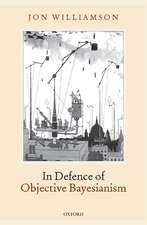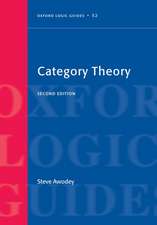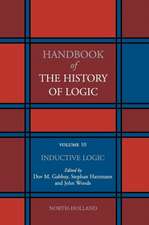Possibility Theory: An Approach to Computerized Processing of Uncertainty
Autor Didier Dubois, Henri Pradeen Limba Engleză Paperback – 13 mar 2012
Preț: 514.94 lei
Preț vechi: 643.67 lei
-20% Nou
Puncte Express: 772
Preț estimativ în valută:
98.53€ • 103.15$ • 81.53£
98.53€ • 103.15$ • 81.53£
Carte tipărită la comandă
Livrare economică 01-07 aprilie
Preluare comenzi: 021 569.72.76
Specificații
ISBN-13: 9781468452891
ISBN-10: 1468452894
Pagini: 280
Dimensiuni: 178 x 254 x 15 mm
Greutate: 0.54 kg
Ediția:Softcover reprint of the original 1st ed. 1988
Editura: Springer Us
Colecția Springer
Locul publicării:New York, NY, United States
ISBN-10: 1468452894
Pagini: 280
Dimensiuni: 178 x 254 x 15 mm
Greutate: 0.54 kg
Ediția:Softcover reprint of the original 1st ed. 1988
Editura: Springer Us
Colecția Springer
Locul publicării:New York, NY, United States
Public țintă
ResearchDescriere
In
the
evolution
of
scientific
theories,
concern
with
uncertainty
is
almost
invariably
a
concomitant
of
maturation.
This
is
certainly
true
of
the
evolution·
of
physics,
economics,
operations
research,
communication
sciences,
and
a
host
of
other
fields.
And
it
is
true
of
what
has
been
happening
more
recently
in
the
area
of
artificial
intelligence,
most
notably
in
the
development
of
theories
relating
to
the
management
of
uncertainty
in
knowledge-based
systems.
In
science,
it
is
traditional
to
deal
with
uncertainty
through
the
use
of
probability
theory.
In
recent
years,
however,
it
has
become
increasingly
clear
that
there
are
some
important
facets
of
uncertainty
which
do
not
lend
themselves
to
analysis
by
classical
probability-based
methods.
One
such
facet
is
that
of
lexical
elasticity,
which
relates
to
the
fuzziness
of
words
in
natural
languages.
As
a
case
in
point,
even
a
simple
relation
X,
Y,
and
Z,
expressed
as
if
X
is
small
and
Y
is
very
large
then
between
Z
is
not
very
small,
does
not
lend
itself
to
a
simple
interpretation
within
the
framework
of
probability
theory
by
reason
of
the
lexical
elasticity
of
the
predicates
small
and
large.
Cuprins
1.
Measures
of
Possibility
and
Fuzzy
Sets.-
1.1.
Imprecision
and
Uncertainty.-
1.2.
Traditional
Models
of
Imprecision
and
Uncertainty.-
1.3.
Confidence
Measures.-
1.3.1.
Measures
of
Possibility
and
of
Necessity.-
1.3.2.
Possibility
and
Probability.-
1.4.
Fuzzy
Sets.-
1.5.
Elementary
Fuzzy
Set
Operations.-
1.6.
Practical
Methods
for
Determining
Membership
Functions.-
1.6.1.
Vague
Categories
as
Perceived
by
an
Individual.-
1.6.2.
Fuzzy
Sets
Constructed
from
Statistical
Data.-
1.6.3.
Remarks
on
the
Set
of
Degrees
of
Membership.-
1.7.
Confidence
Measures
for
a
Fuzzy
Event.-
1.8.
Fuzzy
Relations
and
Cartesian
Products
of
Fuzzy
Sets.-
References.-
2.
The
Calculus
of
Fuzzy
Quantities.-
2.1.
Definitions
and
a
Fundamental
Principle.-
2.1.1.
Fuzzy
Quantities,
Fuzzy
Intervals,
Fuzzy
Numbers.-
2.1.2.
The
Extension
Principle.-
2.2.
Calculus
of
Fuzzy
Quantities
with
Noninteractive
Variables.-
2.2.1.
Fundamental
Result.-
2.2.2.
Relation
to
Interval
Analysis.-
2.2.3.
Application
to
Standard
Operations.-
2.2.4.
The
Problem
of
Equivalent
Representations
of
a
Function.-
2.3.
Practical
Calculation
with
Fuzzy
Intervals.-
2.3.1.
Parametric
Representation
of
a
Fuzzy
Interval.-
2.3.2.
Exact
Practical
Calculation
with
the
Four
Arithmetic
Operations.-
2.3.3.
Approximate
Calculation
of
Functions
of
Fuzzy
Intervals.-
2.4.
Further
Calculi
of
Fuzzy
Quantities.-
2.4.1.
“Pessimistic”
Calculus
of
Fuzzy
Quantities
with
Interactive
Variables.-
2.4.2.
“Optimistic”
Calculus
of
Fuzzy
Quantities
with
Noninteractive
Variables.-
2.5.
Illustrative
Examples.-
2.5.1.
Estimation
of
Resources
in
a
Budget.-
2.5.2.
Calculation
of
a
PERT
Analysis
with
Fuzzy
Duration
Estimates.-
2.5.3.
A
Problem
in
the
Control
of
a
Machine
Tool.-
Appendix:
Computer
Programs.-
References.-
3.
The
Use
of
Fuzzy
Sets
for
the
Evaluation
and
Ranking
of
Objects.-
3.1.
A
Quantitative
Approach
to
Multiaspect
Choice.-
3.1.1.
Basic
Principles
of
the
Approach.-
3.1.2.
Fuzzy
Set-Theoretic
Operations.-
3.1.3.
Application
to
the
Combination
of
Criteria.-
3.1.4.
Identification
of
Operators.-
3.1.5.
Example.-
3.2.
Comparison
of
Imprecise
Evaluations.-
3.2.1.
Comparison
of
a
Real
Number
and
a
Fuzzy
Interval.-
3.2.2.
Comparison
of
Two
Fuzzy
Intervals.-
3.2.3.
Ordering
of
n
Fuzzy
Intervals.-
3.2.4.
Computer
Implementation.-
3.2.5.
Example.-
Appendix:
Computer
Programs.-
References.-
4.
Models
for
Approximate
Reasoning
in
Expert
Systems.-
4.1.
Remarks
on
Modeling
Imprecision
and
Uncertainty.-
4.1.1.
Credibility
and
Plausibility.-
4.1.2.
Decomposable
Measures.-
4.1.3.
Vague
Propositions.-
4.1.4.
Evaluating
the
Truth
Value
of
a
Proposition.-
4.2.
Reasoning
from
Uncertain
Premises.-
4.2.1.
Deductive
Inference
with
Uncertain
Premises.-
4.2.2.
Complex
Premises.-
4.2.3.
Combining
Degrees
of
Uncertainty
Relative
to
the
Same
Proposition.-
4.3.
Inference
from
Vague
or
Fuzzy
Premises.-
4.3.1.
Representation
of
the
Rule
“if
X
is
A,
then
Y
is
B”.-
4.3.2.
“Generalized”
Modus
Ponens.-
4.3.3.
Complex
Premises.-
4.3.4.
Combining
Possibility
Distributions.-
4.4.
Brief
Summary
of
Current
Work
and
Systems.-
4.5.
Example.-
Appendix
A..-
Appendix
B:
Computer
Programs.-
References.-
5.
Heuristic
Search
in
an
Imprecise
Environment,
and
Fuzzy
Programming.-
5.1.
Heuristic
Search
in
an
Imprecise
Environment.-
5.1.1.
A
and
A*
Algorithms.-
5.1.2.
The
Classical
Traveling
Salesman
Problem
(Reminder).-
5.1.3.
Heuristic
Search
with
Imprecise
Evaluations.-
5.1.4.
Heuristic
Search
with
Fuzzy
Values.-
5.2.
An
Example
of
Fuzzy
Programming:
Tracing
the
Execution
of
an
Itinerary
Specified
in
Imprecise
Terms.-
5.2.1.
Execution
and
Chaining
of
Instructions.-
5.2.2.
Illustrative
Example.-
5.2.3.
Problems
Arising
in
Fuzzy
Programming.-
5.2.4.
Concluding
Remarks.-
Appendix:
Computer
Programs.-
A.1.
Selection
of
“the
Smallest”
of
N
Fuzzy
Numbers.-
A.2.
Tracing
Imprecisely
Specified
Itineraries.-
References.-
6.
Handling
of
Incomplete
or
Uncertain
Data
and
Vague
Queries
in
Database
Applications.-
6.1.
Representation
of
Incomplete
or
Uncertain
Data.-
6.1.1.
Representing
Data
by
Means
of
Possibility
Distributions.-
6.1.2.
Differences
and
Similarities
with
Other
Fuzzy
Approaches.-
6.1.3.
Dependencies
and
Possibilistic
Information.-
6.2.
The
Extended
Relational
Algebra
and
the
Corresponding
Query
Language.-
6.2.1.
Generalization
of
?-Selection.-
6.2.2.
Cartesian
Product,
?-Join,
and
Projection.-
6.2.3.
Union
and
Intersection—Redundancy.-
6.2.4.
Queries
Employing
Other
Operations.-
6.3.
Example.-
6.3.1.
Representation
of
Data.-
6.3.2.
Examples
of
Queries.-
6.4.
Conclusion.-
Appendix:
Computer
Program.-
A.1.
Data
Structures.-
A.2.
Representation
of
Queries.-
A.3.
Description
of
Implemeted
Procedures.-
References.

















